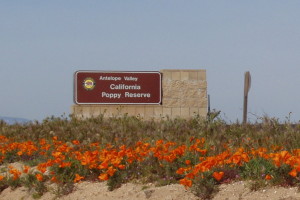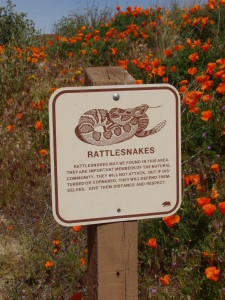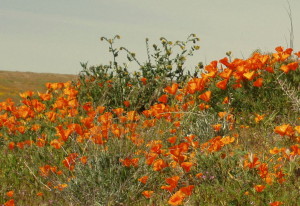Seeing the fields of the California poppies, those delicate orange flowers which bloom in the early spring, is truly a wonderful sight to see. (After this harsh winter in the Midwest, I am definitely missing the sunshine and scenery of the state of my birth!) The Antelope Valley California Poppy Reserve is a great place to see an abundance of the colorful poppies. The reserve is located in the western Mojave Desert, 85 miles from Los Angeles, and it is known for the beautiful fields of poppies that cover the surrounding gentle sloping hillsides.
 The California poppy (eschscholzia californica) is a flowering plant native to the United States and Mexico. The flowers bloom annually and the plants can range in height from 5 to 60 inches tall with blue-green leaves. A single flower grows on each stem and each flower is made up of four orange petals that can measure almost inch or two inches long. The early Spanish settlers of California called the poppy by the name of dormidera, which means drowsy one, because the petals of the poppies close at night opening again with the morning sunshine. The poppy petals also close in cold weather or cloudy days. The poppies normally bloom from mid-February to late May and the date can vary from year to year depending on the amount of rainfall prior to the blooming season.
The California poppy (eschscholzia californica) is a flowering plant native to the United States and Mexico. The flowers bloom annually and the plants can range in height from 5 to 60 inches tall with blue-green leaves. A single flower grows on each stem and each flower is made up of four orange petals that can measure almost inch or two inches long. The early Spanish settlers of California called the poppy by the name of dormidera, which means drowsy one, because the petals of the poppies close at night opening again with the morning sunshine. The poppy petals also close in cold weather or cloudy days. The poppies normally bloom from mid-February to late May and the date can vary from year to year depending on the amount of rainfall prior to the blooming season.
The Antelope Valley California Poppy Reserve is a protected area of the Mojave Desert and is administered by the California Department of Parks and Recreation. The reserve offers a great viewing area for the colorful poppies that grow with a mixture of other wildflowers that cover the gentle hillsides each spring. The California State Park leaves the flowers in their natural state and does not water the flowers. Also in order to protect and regulate the growth of the poppies, the California Poppy Reserve prohibits sheep and cattle from grazing on the surrounding hillsides and since 1994 controlled fires have been used to clear dead brush and invasive plants within the reserve.
Antelope Valley California Poppy Reserve – Travel information and tips
- The Jane. S. Pinheiro Interpretive Center is a great place to start any visit to the Antelope Valley California Poppy Reserve. The center is opened seasonally and visitors can watch a short video, see several the displays on wildflowers, plants and wildlife or pick up maps and other information. Also on display in the center are the wildflower pencil drawings and watercolor paintings of Pinheiro, she was a local artist who was involved in the civic affairs of the Antelope Valley and instrumental in establishing the California Poppy Reserve and the center is named in her honor.
- There are over seven miles of hiking trails at the 1,760 acre reserve. The Antelope Loop Trail covers some of the area portions of the trail are easy gentle slopes and some are more steep climbs over the hills. Before starting out on the trails, check with the park staff for the best hikes for your abilities.
- Picking or destroying the poppies in the park is a violation of the California State law. Please do not collect any items; all natural elements of the reserve are protected including other plants, rocks and wildlife.
- Please be aware that rattlesnakes are present in the area. If you see one on the hiking trails, they are not normally aggressive and will not attack unless threatened. The rattlesnakes are important to the natural environment of the desert and are needed to keep the rodent population down because the animals would consume and destroy the poppies.
- The desert weather can be very unpredictable and temperatures can vary or change throughout the day. Be sure to wear sunblock and bring a light jacket depending on the weather conditions.
- Please do not bring dogs or other animals to the reserve with the exception of service dogs. Horses and mountain bikes are no allowed on the trails.
- For the Antelope Valley California Poppy Center location or directions, please check out the Antelope Valley California Poppy Center website through the following link, www.parks.ca.gov
- For the current season’s poppy/wildflower bloom information call the Poppy Reserve Wildflower Hotline at (661)724-1180 or the Theodore Payne Foundation Wildflower Hotline at (818) 768-3533.



